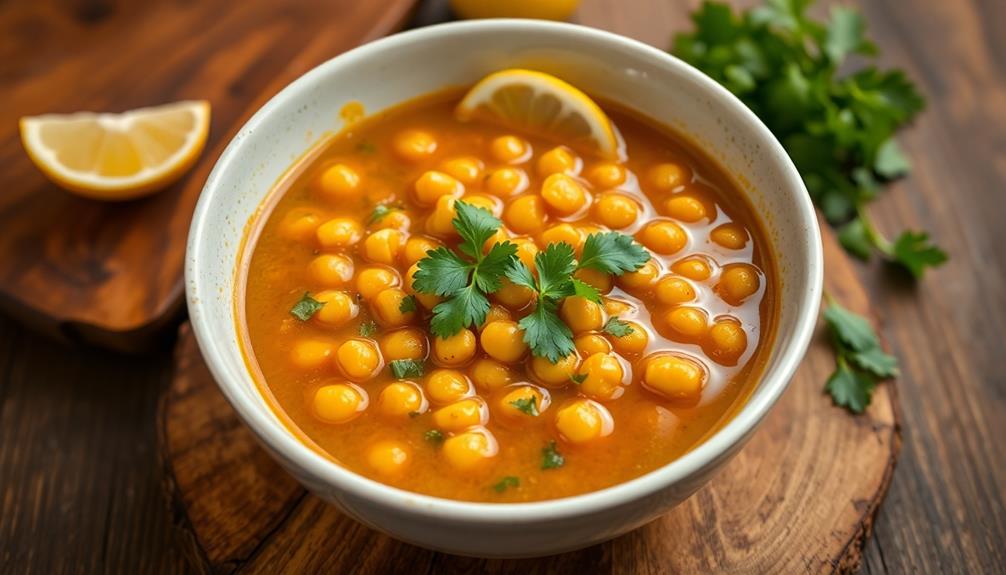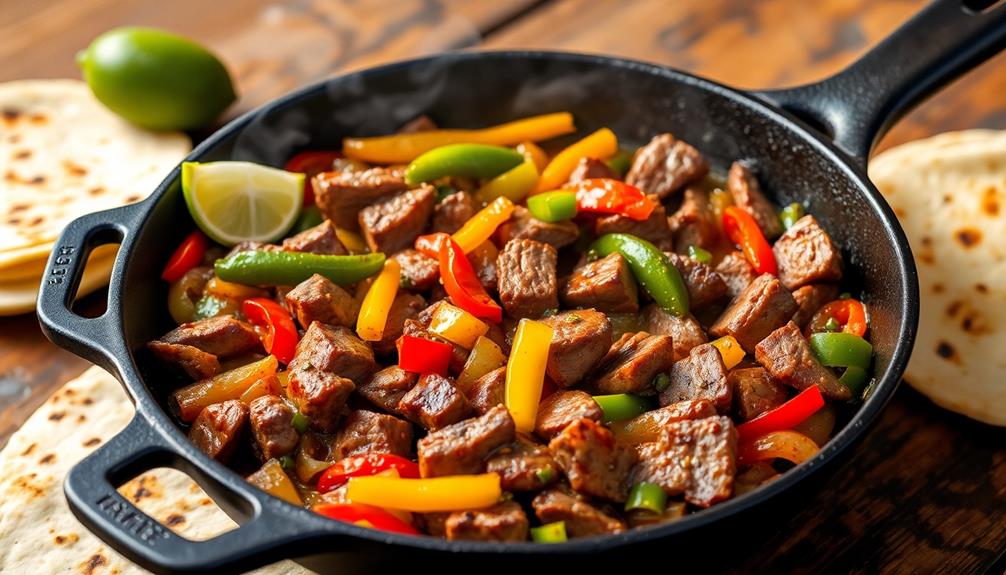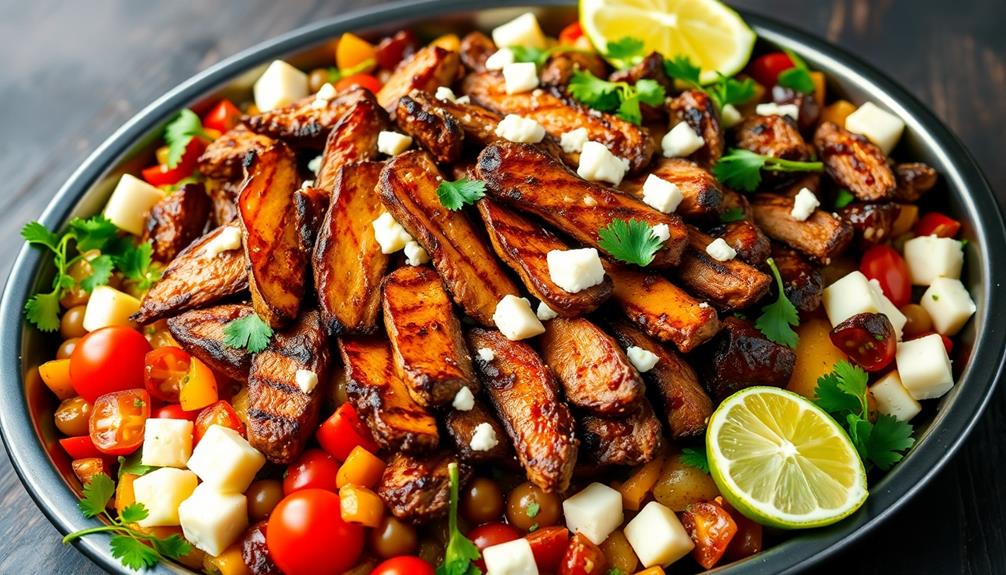Mole poblano is a spellbinding Mexican dish that'll transport your tastebuds on a flavor journey! This velvety sauce combines the bold warmth of toasted chiles, the nutty richness of almonds and chocolate, and a symphony of aromatic spices. It's a culinary work of art, blending indigenous and Spanish influences to create a truly memorable meal. Served over fluffy white rice or nestled in soft tortillas, mole poblano is a celebration of Mexico's vibrant food culture. Prepare to be enchanted by the contrasting textures and harmonious flavors in every bite. There's so much more to discover about this beloved dish!
Key Takeaways
- Mole Poblano is a traditional Mexican dish originating from Puebla, representing a fusion of indigenous and Spanish culinary traditions.
- It is a celebrated dish showcasing the diversity and creativity of Mexican cuisine, often served during special occasions and celebrations.
- The complex flavor profile of mole poblano combines roasted chiles, toasted nuts, warm spices, and chocolate, resulting in a rich, velvety sauce.
- Mole Poblano is commonly paired with fluffy white rice or soft tortillas, and garnished with cool, creamy avocado and tangy queso fresco.
- Enjoying mole poblano is an immersive, hands-on experience that fosters connection and conviviality among diners, reflecting the cultural significance of this iconic Mexican dish.
History
The origins of mole poblano trace back to the vibrant culinary traditions of Puebla, Mexico. This rich and complex sauce has been a beloved part of Mexican cuisine for centuries, with its roots reaching deep into the country's history.
Mole poblano was first developed by the skilled cooks of Puebla, who blended an array of spices, chiles, nuts, seeds, and chocolate to create a truly unique flavor profile. The name "mole" comes from the Nahuatl word "molli," meaning sauce or concoction.
Over time, mole poblano has become a celebrated dish, showcasing the incredible diversity and creativity of Mexican food.
Today, mole poblano is enjoyed throughout Mexico and around the world, with each region and household having its own special twist on the classic recipe.
Whether you're dipping warm tortillas or spooning it over tender meat, this beloved sauce is sure to delight your senses and transport you to the vibrant heart of Puebla.
Recipe
Mole Poblano is a rich and complex Mexican dish that originates from the city of Puebla. It's a labor-intensive but rewarding recipe, combining a variety of spices, dried chiles, and chocolate to create a unique and flavorful sauce. The end result is a velvety, aromatic, and slightly sweet sauce that pairs perfectly with chicken or other proteins.
Preparing Mole Poblano requires patience and attention to detail, but the end result is well worth the effort. The depth of flavor and complexity in this dish make it a true culinary masterpiece.
- 4 dried ancho chiles
- 3 dried pasilla chiles
- 3 dried mulato chiles
- 1 onion, diced
- 4 cloves garlic, minced
- 2 tomatoes, diced
- 1 cup chicken or vegetable broth
- 1/4 cup raisins
- 1/4 cup almonds, toasted
- 2 tablespoons sesame seeds, toasted
- 2 tablespoons peanut butter
- 2 ounces Mexican chocolate, chopped
- 1 teaspoon ground cinnamon
- 1 1/2 teaspoon ground cloves
- 1 1/2 teaspoon ground cumin
- 1 1/2 teaspoon ground coriander
- Salt and pepper to taste
In a large saucepan, toast the dried chiles over medium heat until fragrant, about 2-3 minutes. Remove the stems and seeds, and soak the chiles in hot water for 30 minutes.
Drain the chiles and transfer to a blender or food processor. Add the onion, garlic, tomatoes, broth, raisins, almonds, sesame seeds, peanut butter, chocolate, cinnamon, cloves, cumin, and coriander. Blend until a smooth, thick sauce forms.
Mole Poblano is best served with chicken, but can also be enjoyed with pork, beef, or vegetarian proteins. Top with toasted sesame seeds, chopped cilantro, and a squeeze of lime juice for a truly authentic experience.
Cooking Steps
First, you'll toast the chiles and spices to bring out their bold flavors.
Next, you'll blend the chiles, spices, and broth into a richly flavored sauce.
Then, you'll stir in creamy chocolate and crunchy nuts to give the mole its signature taste and texture.
Step 1. Toast Chiles and Spices

Begin by toasting the dried chiles and spices in a heavy skillet over medium heat.
Don't walk away – keep a close eye on them, gently stirring often, until you can smell their fragrant aroma filling the air. The chiles should start to puff up and the spices should become toasted and darkened in color.
This crucial step brings out all the rich, complex flavors that make mole so delicious.
Next, transfer the toasted chiles and spices to a blender or food processor.
Add a splash of broth or water and blend until you have a smooth, thick paste.
This mixture is the foundation of the mole – it provides the deep, intense flavor that makes this dish so special.
With the hard part done, you're well on your way to creating an authentic, homemade mole poblano that will wow your family and friends.
Step 2. Blend Chiles, Spices, and Broth
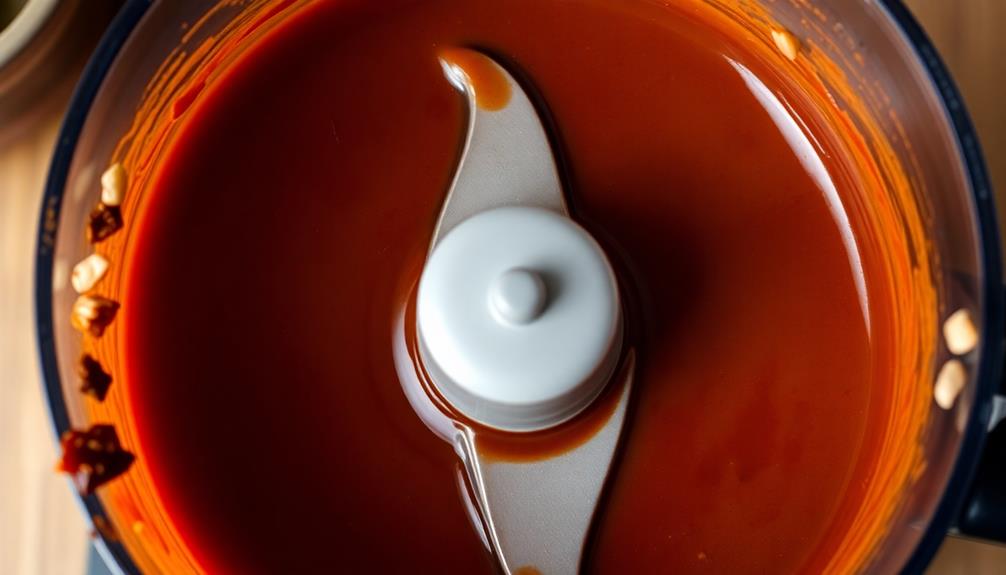
With the chiles and spices toasted to perfection, you'll now want to blend them into a smooth, thick paste. In your blender, add the dried chiles, cinnamon, cloves, allspice, and a bit of the broth to get things started.
Go slowly and blend until the mixture becomes silky smooth. You may need to add more broth as you go to achieve the right consistency – not too thick, not too thin.
Once it's all blended up, you'll be amazed at the rich, deep color and the complex, fragrant aroma. This blend of roasted chiles and spices is the foundation of the mole poblano, so take your time to get it just right.
With the hard part out of the way, you're well on your way to creating an authentic, homemade mole poblano that will wow your family and friends.
Step 3. Add Chocolate and Nuts
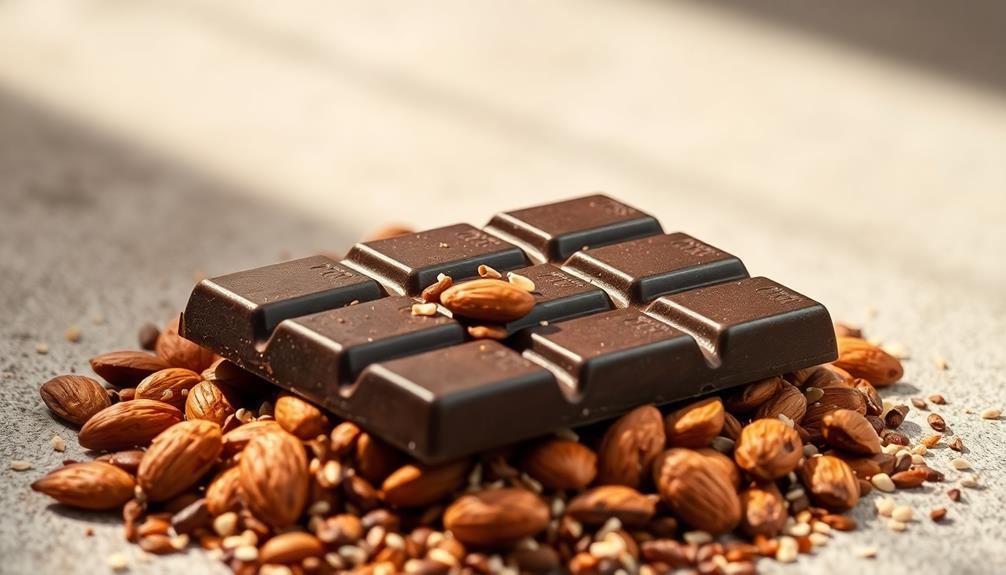
Next, you'll want to add some chocolate and nuts to the mole sauce. This is where the magic really happens!
First, grab a few ounces of high-quality dark chocolate and chop it up into small pieces. The chocolate will melt into the sauce, creating a rich, velvety texture.
Now, it's time for the nuts! Toasted almonds or peanuts work great. Just give them a rough chop so they're in bite-sized pieces. The nuts will add a lovely crunch and nuttiness to balance out the chocolate.
Carefully stir the chocolate and nuts into the simmering mole sauce. As the chocolate melts, the mixture will become smooth and glossy.
Take a deep breath and enjoy the heavenly aroma – the chocolate and spices create a magical scent that will have your mouth watering.
Give it a taste and adjust the seasonings as needed. Now you're ready to serve this authentic, flavorful mole poblano!
Step 4. Sauté Onion and Garlic
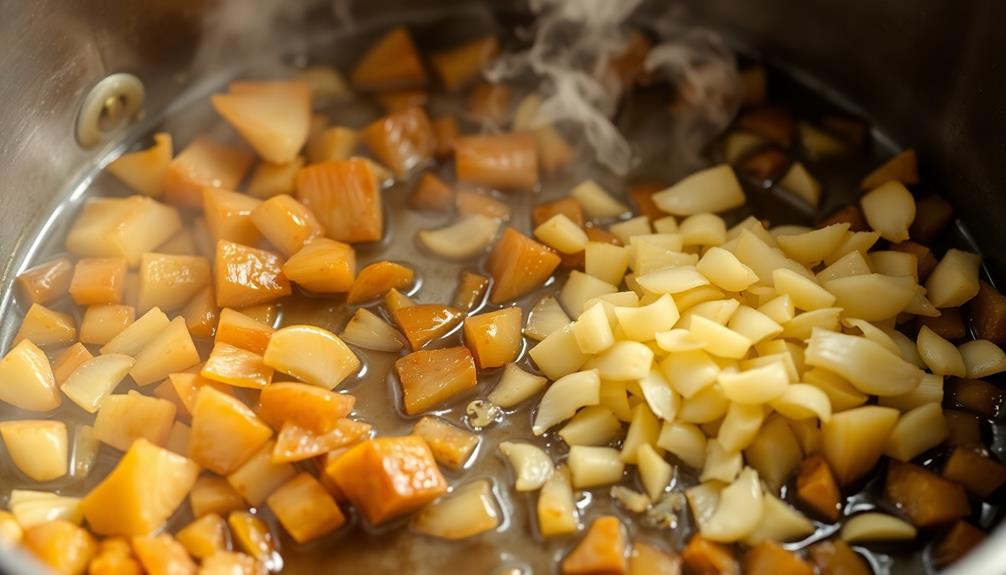
To start the mole poblano, sauté the onion and garlic. Heat a large skillet over medium heat and add a splash of oil. Once the oil is hot, add the diced onion and minced garlic.
Sauté these aromatic veggies, stirring frequently, until they're nice and soft, about 5-7 minutes. You'll know they're ready when the onions turn translucent and the garlic becomes fragrant.
As the onion and garlic cook, the kitchen will fill with the most mouthwatering scents! The onion's sweetness and the garlic's savory notes will blend together, creating a wonderful foundation for the rich, complex flavors of the mole.
Be sure to keep a close eye on the skillet, adjusting the heat as needed to prevent burning.
Once the onion and garlic are perfectly sautéed, you're ready to move on to the next step in crafting your authentic mole poblano. Get ready for some serious flavor magic!
Step 5. Add Chicken and Simmer
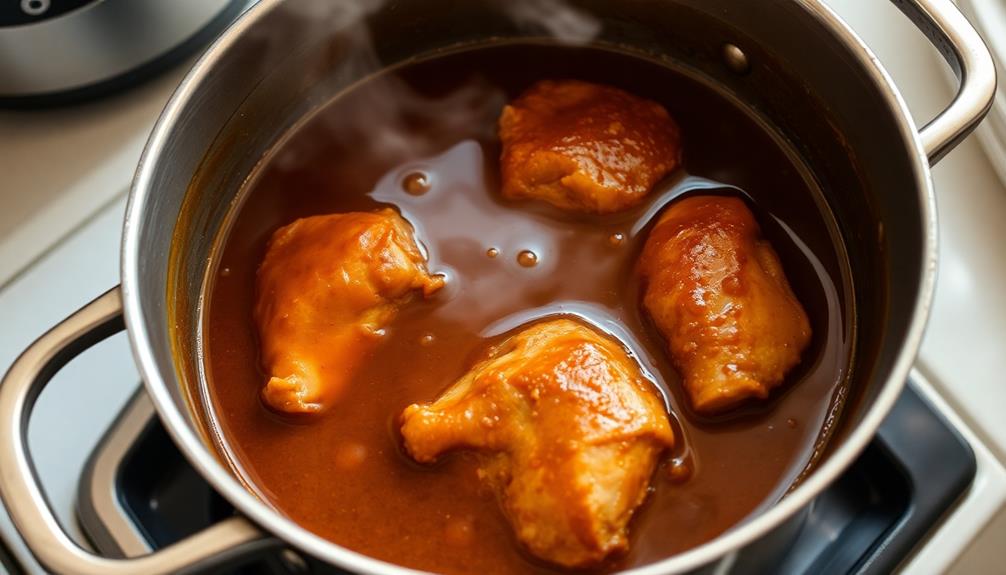
Add the chicken to the sautéed onion and garlic. Don't be shy – just plop those pieces right into the pot!
Now, let's get that chicken simmering away. You'll want to pour in some broth or water, enough to cover the chicken. Bring everything to a gentle boil, then reduce the heat and let it simmer for about 20 minutes.
As the chicken cooks, you'll notice the flavors start to mingle and meld together. The onion and garlic will infuse the chicken with their savory goodness, while the simmering liquid helps keep the meat tender and juicy.
Give the pot a stir every now and then, just to make sure nothing sticks to the bottom.
When the 20 minutes are up, use a fork to check that the chicken is cooked through. It should be opaque throughout and easy to shred with a couple of forks.
Now you're ready to move on to the next step – adding the signature mole sauce! Get excited, because the best is yet to come.
Final Thoughts
Mole poblano is a complex and delightful dish that rewards the patient cook. The rich, velvety sauce is a harmonious blend of roasted chiles, toasted nuts, warm spices, and a touch of chocolate – a flavor explosion that delights the senses.
As the chicken simmers in the aromatic sauce, the meat becomes tender and infused with all those wonderful flavors.
Now, it's time to savor the fruits of your labor. Scoop the mole poblano over fluffy white rice or soft tortillas, and top it with cool, creamy avocado and a sprinkle of tangy queso fresco.
Each bite is a symphony of textures and tastes that will transport you to the heart of Mexico. Don't be afraid to get your hands a little dirty – this is a dish meant to be enjoyed with gusto.
Frequently Asked Questions
How Do I Make Mole Poblano Vegetarian?
To make a vegetarian version, simply replace the traditional meat with hearty vegetables like roasted mushrooms, eggplant, or winter squash. You can also use tofu or tempeh to add protein while maintaining the rich, complex flavors of the dish.
Where Can I Find the Authentic Ingredients for Mole Poblano?
You can find the authentic ingredients for mole poblano at specialty Latin American or Mexican grocery stores. Look for items like dried chili peppers, spices, nuts, chocolate, and other traditional components used in this complex and flavorful sauce.
How Long Can I Store Leftover Mole Poblano Sauce?
You can store leftover mole sauce in the refrigerator for up to a week or in the freezer for up to 3 months. Be sure to store it in an airtight container to maintain freshness.
Can I Use a Slow Cooker to Make Mole Poblano?
You can certainly use a slow cooker to make your mole poblano. The slow, gentle cooking method helps develop the rich, complex flavors of this traditional Mexican sauce. Just be sure to follow the recipe closely for best results.
Is Mole Poblano Typically Served With a Specific Type of Rice?
Yes, mole poblano is often served with a specific type of rice. Traditionally, it's paired with a simple Mexican white rice, which complements the rich, complex flavors of the mole sauce perfectly.

